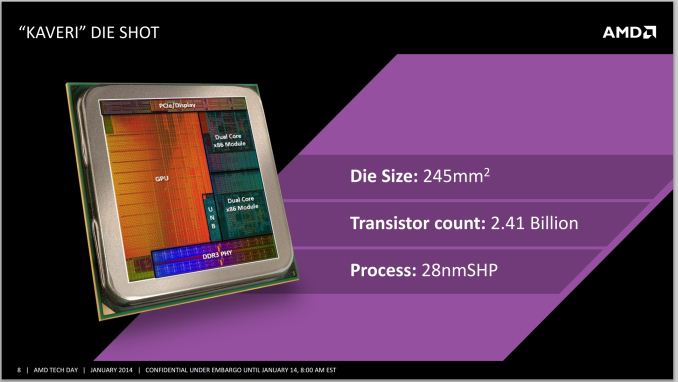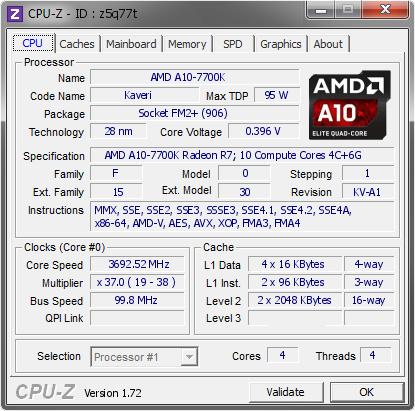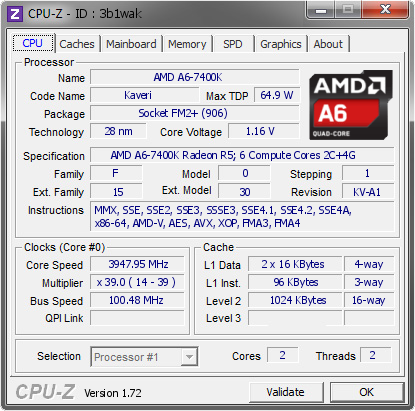The AMD A10-7700K and AMD A6-7400K CPU Mini-Review
by Ian Cutress on May 27, 2015 9:00 AM ESTAMD A10-7700K and AMD A6-7400K Conclusion
I started this mini-review stating that the question of the number of processors that both Intel and AMD produce all seem to differ by 100 MHz and $7, and that I had received questions as to why this is the case. Ultimately a lot of recommendations for computer components start to revolve around ‘Well for $10 more, you could get this’, and at some point you are considering something that costs $50 more. There has to be a point where you stop, especially if an IT department or system builder wants to go through and develop 200+ machines in a month.
Intel and AMD currently have different approaches to this. Intel likes to launch a big part of its stack all at once. Sometimes it will launch individual units outside this, or it will start a new line-up with one or two units then introduce the bulk later. With Haswell for example, on the socketed CPU space, we have 50 different CPUs varying in price, power, frequency, core count, threading and integrated graphics. Imagine the poor reviewer that has to test them all (insert here that I’d love to test them to get all the data, if I had time and could source them)!
AMD’s approach to Kaveri is to dribble rather than gush. Rather than overload the user base (both end-users and commercial) with a large haystack of parts, they launched two or three SKUs on day one, then one or two every 6-12 weeks since. This has some benefits, namely the improvement of the production process over time, the repeated opportunities to market new products and the opportunity to re-educate potential clients through the media. The downside of this strategy is one similar to starting with Swiss cheese and then filling in the holes – if a client wants a SKU with particular characteristics but the company does not have it, then they will go look for something else and take their money with them. It’s a method that acts as a double edged sword.
As AnandTech’s CPU editor, I get to play with a lot more SKUs than most. This means both the big shiny halo products, such as the 8-core goliaths, but also some of the higher volume dual core stuff which is more in line with a budget PC or mass PC build. With AMD’s strategy, as they have fewer processors overall, our coverage can be a little more complete than the others. AMD sampled us both the A10-7700K and the A6-7400K for this purpose, and we hope to work closely with them for future launches and get the best comparison list of their product stack.
Back to the SKUs tested for this mini-review, we can tell that the A10-7700K keeps up with the other A10 parts in our CPU testing, but as it has two fewer compute units in the integrated graphics it can lag behind a little and is more in line with the A8 processors in that regard, essentially making it more of a hybrid part. The A6-7400K fits into that budget CPU line at $64, and the results show this in both our CPU and GPU testing. The single module performs well enough in single threaded environments, but doesn’t have enough legs for the big tasks and can be swamped easily. Despite having two threads, the Bulldozer based design still has single-threaded like behavior in some tests. That being said, the graphics tests are a mixed bag. For titles that can use more threads, I can’t help but feel that it is a little held back, even at 256 SPs. For other titles, it performs on par with other processors almost double its price. Dual Graphics mode unfortunately was not possible with the A6, and it was also noticeable that some games (Shadows of Mordor in particular) took longer to load with only one module.
To say AMD’s APUs are like marmite (you either love them or hate them) is to gloss over a more complex issue. AMD’s design has its plus points and its negative points, a fact that AMD marketing knows when I speak to them. Nevertheless, they have to focus on the plus points, which include gaming at equivalent price points, DX12 support, OpenCL performance and moving forward with HSA. Using the right tool for the right job should now be considered a cliché, but it rings true when it comes to technology and more so than ever when innovative methods are continually being fashioned. Based on AMD’s Financial Analyst Day and their recent exposure into HBM (I highly suggest reading Ryan’s awesome writeup on it), I can safely say that I want to see an APU with HBM in the future. Despite the inevitability that AMD already know that people want one, I told them anyway. We will have to wait and see.














105 Comments
View All Comments
testbug00 - Wednesday, May 27, 2015 - link
Perhaps a thing on overclocking the GPU would be a nice little thing to add into these articles on APUs. If possible.Refuge - Wednesday, May 27, 2015 - link
I don't think I've ever heard of anyone overclocking the integrated GPU in their CPU.That would be an interesting read, but I doubt it was translate to anything between heat and an already bandwidth starved GPU. I don't see OC helping anyone with these.
Edens_Remorse - Wednesday, May 27, 2015 - link
eteknix has a great 7850k review that covers overclocking - definitely worth a read. Nothing like this sham of an article at all.testbug00 - Thursday, May 28, 2015 - link
I've overclocked a Trinity to around 1Ghz from it's base 800Mhz. 5-10% performance increase.yannigr2 - Wednesday, May 27, 2015 - link
Is it so difficult to replace in the charts the prices of AMD APUs with the correct latest OFFICIAL prices? If AMD was selling A10 7850K OFFICIALLY at $50 today(just for example) why read $173 in the charts?Don't get it really, and I don't expect a serious answer. Probably someone will ask me again if I want gaming benchmarks first, maybe in an effort to downgrade the value of my post.
MrSpadge - Thursday, May 28, 2015 - link
AMD chips are regularly sold under well under their official price. I think that's why Ian lists the amazon price instead. BTW: that official price is always quoted for shipments of 1000 CPUs and excludes VAT, so it doesn't necessarily match retail prices by definition. One could argue to include both pricings, though. And maybe use a price comparison engine instead of simply Amazon.yannigr2 - Thursday, May 28, 2015 - link
$173 price on the charts today, has nothing to do with reality. The prices from Amazon show that. The prices on Amazon for Intel and on the charts are usually different from $0 to $2-$3. The price of 7850K in $127, on the Amazon $134 and on the charts $173. The difference is almost $40 and that paints a totally different image in performance/dollar than what it is in reality.I don't care if Ian lists the Amazon price or the lowest price on the planet. I just don't like charts that lie. And those charts lie creating a fake performance/dollar image that coincidentally favors the big company.
testbug00 - Thursday, May 28, 2015 - link
Well AMD says that they pricing the chip at $137 currently... It's over that currently.Edens_Remorse - Friday, May 29, 2015 - link
Yeah... no.http://www.amazon.com/AMD-A10-Series-APU-A10-7850K...
Cryio - Wednesday, May 27, 2015 - link
Conclusion? You want a cheap PC with some gaming capabilities? Buy an A8 7650K and overclock it.You want the best gaming PC for the lowest money? Buy a an R9 285 or a GTX 960 and an Athlon 860K. It does the job just the same as an i3 for 40 dollars less.